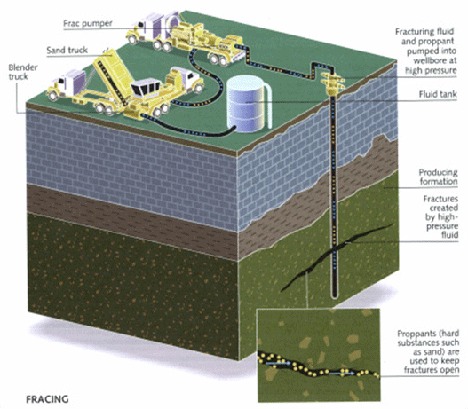Energy
US EPA Links Fracking to Groundwater Contamination (ECA, CHK, XOM, EOG)
Published:
Last Updated:

From the EPA announcement:
EPA constructed two deep monitoring wells to sample water in the aquifer. The draft report indicates that ground water in the aquifer contains compounds likely associated with gas production practices, including hydraulic fracturing. EPA also re-tested private and public drinking water wells in the community. The samples were consistent with chemicals identified in earlier EPA results released in 2010 and are generally below established health and safety standards. To ensure a transparent and rigorous analysis, EPA is releasing these findings for public comment and will submit them to an independent scientific review panel. The draft findings announced today are specific to Pavillion, where the fracturing is taking place in and below the drinking water aquifer and in close proximity to drinking water wells – production conditions different from those in many other areas of the country.
The EPA is careful to note that the study does not present a general indictment of fracking, but is specific to the wells around Pavillion. That distinction may get lost as the debate over fracking continues to heat up.
An Encana spokesman said that the study doesn’t prove anything. Rather, the contamination is a “probability — and based on the facts, not a good probability.” He noted that the methane and benzene that the EPA found were naturally occurring and are common in any gas-rich area.
Much of the detected contaminants were located in close proximity to the waste water pits that hold the fracking fluids after they have been pumped back out of the wells. In its draft report (available here), the EPA found:
Detection of high concentrations of benzene, xylenes, gasoline range organics, diesel range organics, and total purgeable hydrocarbons in ground water samples from shallow monitoring wells near pits indicates that pits are a source of shallow ground water contamination in the area of investigation. When considered separately, pits represent potential source terms for localized ground water plumes of unknown extent. When considered as whole they represent potential broader contamination of shallow ground water. A number of stock and domestic wells in the area of investigation are fairly shallow (e.g., < 30 meters below ground surface) representing potential receptor pathways.
In other words, the fluid in the pits is seeping back into the ground and creating underground plumes that contaminate shallow ground water.
The gas wells at Pavillion are quite shallow, as modern-day drilling goes. The EPA noted that fracking occurred at one well at a depth of just 372 meters (about 1,200 ft). Some domestic and stock wells are as shallow as 800 feet. According to the draft, “With the exception of two production wells, surface casing of gas production wells do not extend below the maximum depth of domestic wells in the area of investigation.” That could allow methane and fracking fluids rather easily to flow into the groundwater.
Hydraulic fracturing of gas fields has been blamed for a rash of earthquakes in Arkansas and implicated in some minor quakes in the Dallas-Fort Worth area. This latest EPA study now links fracking to groundwater contamination. Could be some tough days ahead for producers.
Paul Ausick
Are you ready for retirement? Planning for retirement can be overwhelming, that’s why it could be a good idea to speak to a fiduciary financial advisor about your goals today.
Start by taking this retirement quiz right here from SmartAsset that will match you with up to 3 financial advisors that serve your area and beyond in 5 minutes. Smart Asset is now matching over 50,000 people a month.
Click here now to get started.
Thank you for reading! Have some feedback for us?
Contact the 24/7 Wall St. editorial team.